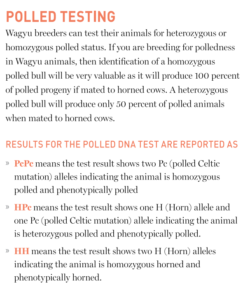THE POLLED GENE IN WAGYU
ALSO KNOWN AS THE CELTIC POLLED ALLELE
In late 2020, the Cattle Council of Australia released information on pain relief options for cattle operations, particularly for dehorning and debudding.
The practice is employed to lower the risk of bruising and injury to other cattle and animal handlers during holding, feedlots and loading. With approval for the use of Trisolfen or dehorning and debudding, farmers can now apply pain-relief in animal husbandry without the need for veterinary supervision.
Dehorning is still a painful procedure, it is recommended that dehorning and debudding occur when the calf is less than two months old, before the horn has attached to the skull. Pain relief and proper practice are recommended to minimise the impact of the procedure on the animal along with reducing the incidence of poorer animal performance in the following weeks. The pain relief guide notes that producers are encouraged to find non-surgical alternatives such as breeding for the polled gene.
The polled gene is another name given for the Celtic polled allele. It is not naturally present in Japanese Black Fullblood Wagyu, but has been introduced to Purebreds through crosses with other breeds.
The polled gene is dominant, such that homozygous (has two copies of the poll gene) polled sires are most desirable as they will always breed polled progeny, even if the progeny themselves are heterozygous (carrying one copy of the polled gene).
If a breeder started with a Fullblood sire over Angus females, 100% of the F1 progeny would be heterozygous polled and would carry one copy of the poll gene from the Angus female and one non-polled gene from the Fullblood Wagyu sire.
Successive upgrade crosses of F1 females to Fullblood Wagyu to produce F2 would give 50% phenotypically polled, and F3 would result in 25% of the progeny as polled. Continuing to Purebreds (or F4) would result in 12.5% being phenotypically polled.
Once you have phenotypically polled purebred females, mating of a heterozygous polled Purebred sire to a heterozygous polled Purebred dam gives a probability of 75% of progeny being phenotypically polled and 25% of the progeny being genetically homozygous polled.
Mating of a homozygous polled Purebred sire to a heterozygous polled Purebred dam gives a probability of 100% of progeny being phenotypically polled and 50% of the progeny being genetically homozygous polled.
The scurred condition (small, loose, horny growths in the skin where horns would be) is controlled by a different gene to the polled gene and scurs are only expressed (visible) in polled cattle with two copies of the scur gene. The scur gene is sex linked and is dominant in males and recessive in females. Breeding polled animals therefore makes it possible to select against the scurred gene and long-term selection for polledness will help to identify and eliminate scurs if scurred animals are culled.
Within the Australian Wagyu herd, a number of producers have opted to focus on the polled gene for Purebreds, without detriment to other traits. The AWA currently holds some 2,000 registered polled Purebred Wagyu.

